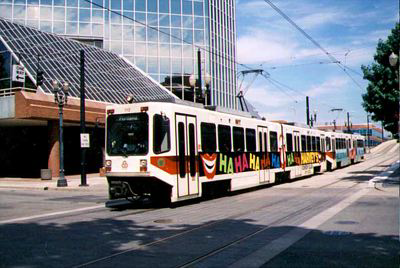No Light Rail in Vancouver!
I often hear people say things like, “Light rail might make sense in Europe, but it doesn’t make sense here because our city isn’t dense enough.” To which I respond, “Light rail doesn’t make sense in Europe either.”
In fact, based on the numbers in the post on moderate-
By the time a city is dense enough to justify rail transit, it is too dense for light-

The proof of this is simple. We know that three-
Light rail does not fit in the efficient transit continuum anywhere except in the
minds of pork-
Now my loyal opponent, Michael Setty (msetty), responded to the moderate-
“The capacity of a particular form of transportation technology has relatively little to do with speed,” he says, “but everything to do with the minimum frequency that trains can operate safely and reliably past a given point.” That is silly. Speed is just as important as frequency. If one mode goes three times faster than another mode, then all else being equal it has three times the capacity.
As an example, for the fiftieth anniversary of the Golden Gate Bridge, the bridge was closed to autos and opened to pedestrians for a morning. In that brief time, far more people walked across the bridge than had ever driven across it in the same time period — so many, in fact, that the bridge actually sagged under their weight.
By Mr. Setty’s criteria, since more people walked past a point than drive, the bridge would do more work if devoted entirely to pedestrians than to autos. In fact, because the autos can go 60 miles per hour and pedestrians only 3, the bridge does far more work serving autos.
Mr. Setty accepts transit agency predictions that a light-
That’s why the real solution to many of our congestion problems is not light rail
or exclusive bus lanes but variable-
Mr. Setty also raises the question of where all the traffic will go. “The Antiplanner is nominally correct that a freeway lane can carry around 600 buses per hour,” he says, “however, this rate is actually achieved only in New York City and then only because the Port Authority Bus Terminal has nearly 300 bus bays that can absorb such volumes.” But that is exactly my point: it takes New York City densities to justify an exclusive bus lane. But if buses can serve those densities, why do we need light rail?
Buses have two advantages over rail. First, they can disperse to many different destinations.
When crossing the Columbia River they can use a high-
The second advantage is that buses can share the road, and therefore the cost of the road, with autos and trucks. This means the road can be used by others when buses aren’t using it. Meanwhile, expensive rail lines sit idle most of the time, either because there is no demand to run frequent trains or because frequencies can be no greater than the safe operating limits of the system — which, as Mr. Setty admits, is about twenty trains per hour for most light rail.
We must also never forget the biggest advantage highways have over rail: Not only
do they cost less, but all or almost all the costs are paid for by users. So even
if light-
Is there a reason why light-
5
Trackback • Posted in Transportation
The Antiplanner’s Law of Rail Transit

Reprinted from The Antiplanner